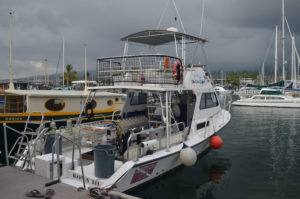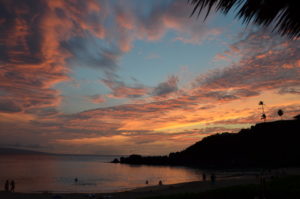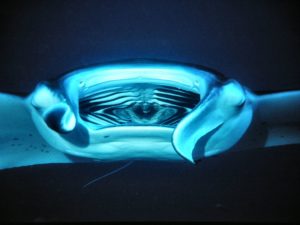= encounters in which an animated creature is present. These include humanoids, robots, and humans who seem to be occupants or pilots of a UFO
J. Allen Hynek
My apologies to the late Dr. Hynek for appropriating one of his levels of alien encounter classification. After all, though I most certainly encountered animated creatures, they were neither occupants nor pilots of a UFO. They were not robotic and they were definitely not humanoid in form. However the realm they inhabited was alien, in most respects totally unfamiliar to me. In actuality, their world could be life-threateningly hostile for a mere human such as me. Their modes of obtaining food, moving about, and reproduction were as strange to me as the behaviors of a being from Dune, Pandora, or Dagobah might be.
As strange as it may seem, meeting these creatures required only simple opportunity on my part. True, the opportunity itself necessitated a bit of effort. Over four thousand miles of travel, some ten hours of flight at three-fourths the speed of sound were necessary. The reward was the chance to peer beneath the stunning, ink-blue waters of the vast Pacific. There, near Kona just off the west coast of Hawaii’s big island, I met the alien creature of my close encounter – the manta ray.

What an amazing animal, surely one of the “endless forms most wonderful” which have inspired me to write the essays you find here. Via Animal Planet or the National Geographic channel, I had long watched these wondrously graceful animals winging their way through their ocean home. I had peered at the screen with envious desire, never imagining that one day I too would find myself afloat in their realm. But, happily, sometimes our dreams do come true.
Snorkeling with manta rays, an adventure provided by Big Island Divers in Kona, was a family affair. Our trip began aboard the worthy vessel Honu Iki sailing from Honokohau Marina.  The boat’s crew made our trip a delightful bundle of exploration, learning, and pure enjoyment. The amiable Captain Mikey delivered his instructions and bits of information with splendidly dry wit and charm. I suspect he would have a good chance of success in a second career as a standup comic. Lucas and Griffin were helpful with equipment fitting and use and hovered over us like protective parents. Snorkel guide Molly gave us an informative introduction to the biology of manta rays and the need for their protection. As I listened to her, I reflected upon the fact that virtually every charismatic animal I learn about these days seems to be under assault.
The boat’s crew made our trip a delightful bundle of exploration, learning, and pure enjoyment. The amiable Captain Mikey delivered his instructions and bits of information with splendidly dry wit and charm. I suspect he would have a good chance of success in a second career as a standup comic. Lucas and Griffin were helpful with equipment fitting and use and hovered over us like protective parents. Snorkel guide Molly gave us an informative introduction to the biology of manta rays and the need for their protection. As I listened to her, I reflected upon the fact that virtually every charismatic animal I learn about these days seems to be under assault.
Manta rays I learned include the largest of all the world’s ray species and are distributed worldwide, mostly in tropical and subtropical waters. Rays are related to sharks and like them have skeletons of cartilage rather than bone. We might think of rays as sharks with really, really huge pectoral fins. The wingspan of the large oceanic mantas averages around twenty-two feet and their weight may be well more than a ton. The more coastal reef mantas are smaller but can still exceed ten feet in wingspan. Manta rays are long-lived individuals, often surving four decades or more. During this time they remain constantly on the move as their modes of breathing and feeding both require the movement of large amounts of water over their gill structures.
Manta rays, like most sharks, give birth to living young. This type of reproduction is called ovoviviparity (c.f. humans who are viviparous). In this type of reproduction, eggs are produced but not immediaely laid. Rather they are retained inside the female until the fetus is developed sufficiently to be born. As with sharks, manta rays practice internal fertilization of their eggs. Males can be distinguished from females by the structure of the former’s pelvic fins. These have folded lobes, referred to as claspers, which are used as a “penis” during mating. Manta pups are around fifty inches in wingspan and weigh twenty pounds or more when born. Normally one pup is produced every two or three years. Such a low birth rate can spell trouble for any animal that is under threat. Female mantas probably don’t sexually mature until they are eight to ten years old. Coupled with their low reproductive rate, this means that species such as the manta simply cannot produce young at a frequency which allows them to recover from over-exploitation.
It is likely that manta rays have been in the subsistence diet of indigenous peoples throughut history. This relatively small harvest manta ray populations could tolerate. The problem now is that manta rays have been commercially targeted. With the use of modern fishing equipment and techniques, large declines in their population numbers have been seen. The National Oceanic and Atmospheric Administration notes that observed sightings/landings of mantas in the Indo-Pacific Region have declined by ninety-seven percent. The reason for the sudden commericial interest in manta rays? A market has developed for the dried gill rakers of these rays.  Although there is apparently no historical usage of these structures in traditional Chinese medicine (nor any scientific evidence of their efficacy), the belief has arisen that manta ray gills may provide relief for everything from acne to cancer. Ninety-nine percent of the gill raker trade is centered in Guanzhou, China. The conservation organization SharkSavers reports that sixty-one thousand kilograms (sixty-seven tons) of manta gill material worth US $11 000 000 has been traded there yearly. Such tonnage represents the death of some ninety-seven thousand manta (and devil) rays.
Although there is apparently no historical usage of these structures in traditional Chinese medicine (nor any scientific evidence of their efficacy), the belief has arisen that manta ray gills may provide relief for everything from acne to cancer. Ninety-nine percent of the gill raker trade is centered in Guanzhou, China. The conservation organization SharkSavers reports that sixty-one thousand kilograms (sixty-seven tons) of manta gill material worth US $11 000 000 has been traded there yearly. Such tonnage represents the death of some ninety-seven thousand manta (and devil) rays.
Many countries now recognize that this degree of exploitation of manta rays is not sustainable. At least fiftenn countries now prohibit the harvesting of manta rays. For example, in 2014 Indonesia announced that it had enacted legislation to protect all manta rays in an almost six million square kilometer area under its jurisdiction. Policing of such protections is difficult in countries such as Indonesia with its far flung and numerous islands. Thus it still shows up as a major source of manta ray gill rakers on the accompanying graphic from the SharkSavers website. Still, one must be encouraged by the intent.  There may be hope for the manta ray. It has been noted that sales of gill rakers in Guangzhou were 60.5 tons in 2011 and 120.5 tons in 2015 with a subsequent decline due to conservation campaigns and changes in government policies.
There may be hope for the manta ray. It has been noted that sales of gill rakers in Guangzhou were 60.5 tons in 2011 and 120.5 tons in 2015 with a subsequent decline due to conservation campaigns and changes in government policies.
Economics has rested at the core of the assault on manta rays. Perhaps finances may ultimately lie at the heart of recovery for these species as well. Fisherman are said to receive, depending on the ray’s size, anywhere from forty dollars to five-hundred dollars for harvesting a manta ray. A 2013 article by Douglas Siefert (The Million Dollar Mantas), which appeared in the journal of the Royal Geographical Society, has pointed out that living manta rays are worth considerably more. Lots more! He uses the mantas of Kona, Hawaii, some of which I encountered, as an example. In the Kailua-Kona area, dive and snorkel operators earn US$3 400 000 per year directly from manta ray excursions. Further, there are known to be 146 manta rays in the resident population. Thus, each of the identified mantas generates US$23,288 a year in revenue. Because of their lengthy lifespan (40+ years), each of these mantas may generate $1 000 000 of revenue over the course of its life. Siefert points out that this doesn’t take into account the money manta excursions funnel toward hotel and car rentals, restaurants, airfares, taxes, and employment. Compared to the worth of a dead manta ray, these are astounding (and attractive) figures for consideration by those who might be able to initiate manta ray viewing trips in their own locales. Let us hope that simple economics can be the engine that drives the preservation of these magnificent creatures. But now, let me climb down from my soapbox and tell you what I saw myself.

At 6:15P HST, the Honu Iki eased out of Konohokau Harbor bound for waters just offshore the Ellison Onizuka-Kona International Airport six miles away. Our boat rose and plunged over the broad, gently rolling swells of the open sea as we motored northward. The sun approached the western horizon and we eagerly anticipated another of the stunning Hawaiian sunsets to which we had become accustomed.
 The waters of the Pacific were a lovely deep blue when we began. Slowly they morphed into inky blackness as the sun at last disappeared below the far horizon. Snorkeling with the manta rays was a night mission.
The waters of the Pacific were a lovely deep blue when we began. Slowly they morphed into inky blackness as the sun at last disappeared below the far horizon. Snorkeling with the manta rays was a night mission.
Arriving at our destination, the Honu Iki tied-off to an underwater mooring and preparations for the evening’s dive began. Of course there had to be some means by which manta rays might be attracted to our parking spot so that we could see them. The Pacific is a little too large to simply jump over the side with fingers crossed in hope of good luck. The secret to our success was to first set up an irresistible buffet for the benefit of the rays.
Like the massive baleen whales, the huge manta rays eat some of the ocean’s smallest inhabitants – plankton. The planktonic organisms in the form of copepods, the larvae of corals and anemones, diatoms, dinoflagellates, and decapod krill swarm earth’s oceans in uncountable numbers. The phytoplanktonic organisms are attracted to artificial light just as they are to sunlight. Thus step one involved one of the crewmen placing a milk crate with two spot-lights on the sea bottom. Next, a flotation device looking much like a surfboard was launched. Projecting downward from this float were more lights. Our artificial suns were in place. The movement of the plant-like plankton (the phytoplankton) toward the lights enticed the animal-like plankton (zooplankton) to follow in search of a meal. It was quite amazing really. The lights came on and an oceanic food chain materialized: light –> plant –> animal. And of course the animal that we hoped would represent the top of that food chain was the manta ray. Into the water we plunged and grasping the handles around the float we hovered, looked downward and eagerly awaited the arrival of the big fish at the top of this feeding pyramid.
Under the lights, the amassed hordes of plankton made it seem as if one were suspended in the midst of a snow storm. The phytoplankton buoyantly drifted, floating in the water, a blizzard of tiny photosynthetic machines. Occasionally, across one’s field of vision, there was the sudden transit of what seemed a miniature meteor. Each marked the mad dash of one of the tiny zooplanktontic animals as it raced to intercept its equally miniscule victim. Several meters below we could see the spotlights sitting on the sea floor, the “campfire” as it was called. And then quite abruptly giant, shadowy forms moved across the lights. As if materializing from the water molecules themselves, suddenly there were manta rays.
As we watched, the mantas coursed back and forth through the column of plankton which had formed above the lights. With their broad oval mouths agape, the rays passed gallon of water over their gills. The aforementioned gill rakers, acting as strainers, trapped the plankton which was then forced to the back of the mouth and gulped down. An exceedingly large manta may eat thirty pounds or more of plankton per day. The manta rays we saw below us took plankton primarily by a method called ram feeding. In this technique, the rays simply plow through a concentration of plankton using the inertia of their movement to intake large volumes of water and the food it contains. We hovered on the surface hopeful that one of the rays would soon find the plankton suspended just below our raft too.
We were not to be disappointed. As I gazed downward into the clear but dark waters, a giant mouth unexpectedly materialized. Straight up came the huge maw. On each side a cephalic fin curved downward and directed water into the mouth.  This enormous mouth was propelled upward by the movements of the ray’s wings (pectoral fins) which spanned over six feet. Surging upward it came toward our float; I braced for what seemed an unavoidable impact. But, at the last second, the manta performed a stunningly precise loop within inches of our faces. This maneuver revealed its brilliant white belly which was etched by distinctive black blotches. These “fingerprints” allow identification of individual rays. Downward the ray now plunged into the pillar of plankton. At the bottom another perfect loop was executed and again the ray ascended toward us like some incoming cartilaginous missile. It was quite obvious that the six hundred pound ray was exquisitely aware of its surroundings, the location of its food source, and the curious onlookers looming above it. Mantas have the largest brain to body mass ratio of any fish and studies suggest that they possess self-awareness. How could it not be totally aware of its environment? As I watched the acrobatics of the ray which was soon joined by a comrade, adjectives tumbled from my unconscious. Graceful, powerful, agile, nimble, beautiful – all most appropriate but so exceptionally inadequate in the presence of this astounding creature.
This enormous mouth was propelled upward by the movements of the ray’s wings (pectoral fins) which spanned over six feet. Surging upward it came toward our float; I braced for what seemed an unavoidable impact. But, at the last second, the manta performed a stunningly precise loop within inches of our faces. This maneuver revealed its brilliant white belly which was etched by distinctive black blotches. These “fingerprints” allow identification of individual rays. Downward the ray now plunged into the pillar of plankton. At the bottom another perfect loop was executed and again the ray ascended toward us like some incoming cartilaginous missile. It was quite obvious that the six hundred pound ray was exquisitely aware of its surroundings, the location of its food source, and the curious onlookers looming above it. Mantas have the largest brain to body mass ratio of any fish and studies suggest that they possess self-awareness. How could it not be totally aware of its environment? As I watched the acrobatics of the ray which was soon joined by a comrade, adjectives tumbled from my unconscious. Graceful, powerful, agile, nimble, beautiful – all most appropriate but so exceptionally inadequate in the presence of this astounding creature.
All too soon our allotted time passed. As we prepared to leave our raft and return to the boat, we were favored by one last pass from another giant. As if to show off its skills as a swimmer and gymnast, the great fish made two amazingly close, looping approaches of 360 degrees. So near was its lustrous white abdomen that I would scarcely have had to extend my hand to touch. With great reluctance, I heeded our pre-dive instructions – hands off! Nevertheless, my desire to know the feel of the ray’s skin, its texture, the strength which rested beneath, and the urge to simply make contact with such an alien being was most powerful. What senses were at work there? What thoughts, perceptions, and integrations were going on in that big brain? What were the secrets it possessed concerning its watery world? How vexingly impenetrable were the mysteries of this close encounter of the third kind.
These questions, the very nearness of the ray, and its extreme strangeness evoked the memory of author Henry Beston’s wonderful insight into those beings who inhabit that galaxy we call the Animalia.
Said Beston, “For the animals shall not be measured by man. In a world older and more complete than ours they move finished and complete, gifted with extensions of the senses we have lost or never attained, living by voices we shall never hear. They are not brethren, they are not underlings. They are other nations caught with ourselves in the net of life and time . . .”
Do I expect too much when I dream that we may someday forge a peace with these “other nations”? Do I ask for the impossible when I hope this truce come soon and be of enduring length? Will we ever recognize the need for humans to become conservers rather than consumers of our world’s wondrous biodiversity?
Afloat in the immense cosmic sea, our planet is a uniquely singular island of life. The manta ray exists nowhere else. Should my visions come to pass, perchance this majestic animal will yet endure. Freed from the gluttonous attention of the gill-seekers, the manta ray will forever swim the vast seas of its planetary home – our home, our Earth.
Photo Credits:
Swimming manta – commons.wikimedia.org/wiki/Manta_birostris#/media/File:Manta_birostris-Thailand3.jpg
Gill rakers in market – www.geographical.co.uk/nature/oceans/item/376-the-million-dollar-mantas
Yearly catches graphic -www.sharksavers.org/en/our-programs/manta-ray-of-hope
Manta and diver – Steve Dunleavy at Wikimedia Commons
Manta mouth – Wikimedia Commons
Dive boat & Hawaiian sunset by the author.
